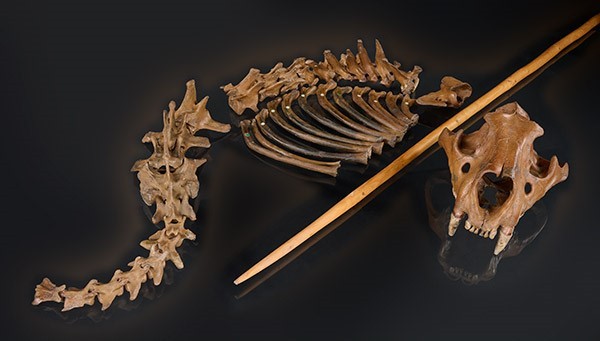Hello Nature readers, would you like to get this Briefing in your inbox free every day? Sign up here.
Neanderthals probably hunted cave lions, the extinct larger and heavier cousins of modern lions, for more than just food. (V. Minkus. NLD)
Neanderthals hunted cave lions
A spear mark on the 48,000-year-old skeleton of a cave lion (Panthera spelaea) is the oldest evidence of Neanderthals hunting the ice-age predators. The puncture crater on the big cat’s rib, initially thought to be a bite mark made by another animal, is probably the result of a fatal stab with a wooden spear. And Neanderthal hunters were probably after more than just meat: a set of cave-lion bones from about 190,000 years ago shows that care had been taken to preserve the cat’s paws and claws as part of the pelt.
Science | 5 min read
Reference: Scientific Reports paper
How our brain steers us toward fatty foods
A brain area helps to guide eating behaviour by responding to the smooth texture of fatty foods. Researchers evaluated the smoothness of milkshakes with varying sugar and fat contents by placing samples between pig tongues and measuring the friction generated while sliding the tongues across each other. Volunteers then tasted the shakes and were asked how much they would pay for a glass of each. Brain scans revealed that activity patterns in an area involved in reward processing reflected the drinks’ texture and the value that participants placed on them.
Nature | 5 min read
Reference: The Journal of Neuroscience paper
Spermidine boosts fertility in old mice
A dietary supplement can reverse signs of ageing in mouse ovaries. Older mice that received spermidine — a compound that was first isolated from sperm but is found in most living cells — had better quality reproductive cells and twice as many pups per litter as did untreated ageing mice. The molecule’s effects on human fertility are still unclear.
Nature | 5 min read
Reference: Nature Aging paper
Argentina candidate vows to slash funding
The candidate leading the polls in Argentina’s upcoming presidential elections says he will shut down the country’s main science agency, CONICET. Economist and tantric sex coach Javier Milei is a libertarian who wants to privatize government research, close the environment and health ministries and abolish the current public-health and education systems to help tame the country’s financial crisis. Researchers suggest that Argentina could face a severe brain drain if Milei is elected president on 22 October.
Nature | 6 min read
Features & opinion
How postdocs use ChatGPT
Almost one-third of the 3,838 postdocs who responded to Nature’s global survey said they used artificial-intelligence chatbots in their work. It has transformed the way that they refine text, analyse data, fix errors in code, translate e-mails or even overcome writer’s block, by putting the first few words on a page. But few institutions offer training or advice on how to use chatbots, which archaeologist Iza Romanowska considers “quite naive”. “We’re all going to use it for work and trying to pretend it doesn’t exist isn’t going to change this.”
Nature | 10 min read
Soft landing for protein structures
A union of mass spectrometry with cryo-electron microscopy could transform scientists’ understanding of complex proteins — if scientists can stick the landing. Usually, images of proteins captured after they come flying out of the spectrometer look like a tomato thrown at a wall. Soft-landing methods have started to change that: they aim to limit the force with which proteins arrive at their final destination. “It has the potential to be the default way people prepare samples for cryo-EM,” says biomolecular chemist Joshua Coon. Now, scientists will have to show that proteins remain intact when they hit their target.
Nature | 12 min read
The day NASA discovered life on Earth
Thirty years ago, astronomer Carl Sagan convinced NASA to turn the Galileo spacecraft’s eyes towards Earth on its journey to Jupiter. His groundbreaking idea: to search for life on the only planet where we’re certain it’s there — and thereby to learn how to look for signs of life on other worlds. “While the answer was known, it profoundly changed our way of thinking about the answer,” says astrobiologist Lisa Kaltenegger.
Nature | 8 min read
Reference: Nature paper (from 1993)
Where I work
Axel Bres is an electronic engineer at Port-aux-Français, a French scientific base located in the Kerguelen sub-Antarctic archipelago, one of the most isolated places in the world.Credit: Patrick Hertzog/AFP via Getty
Every day, electronic engineer Axel Bres fights strong winds to release a weather balloon at Port-aux-Français, a sub-Antarctic scientific base in the Kerguelen archipelago. It’s one of the most isolated places in the world, home to only about 40 biologists and French military personnel. “The community is like a big family, and we organize a lot of activities in our free time,” Bres says. (Nature | 3 min read)
